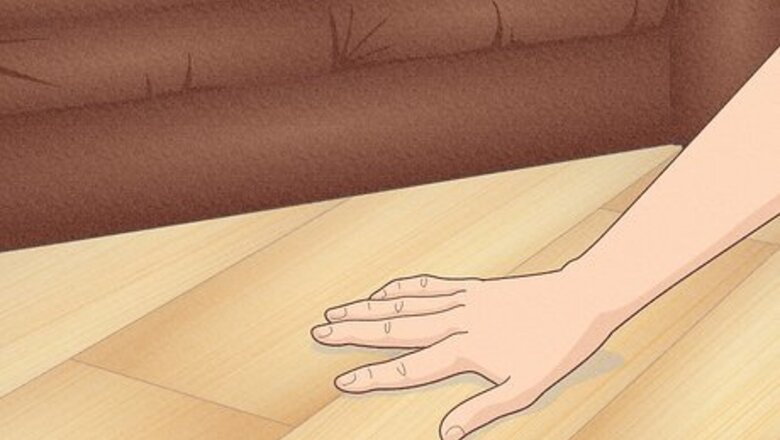
views
Preparing the Floor
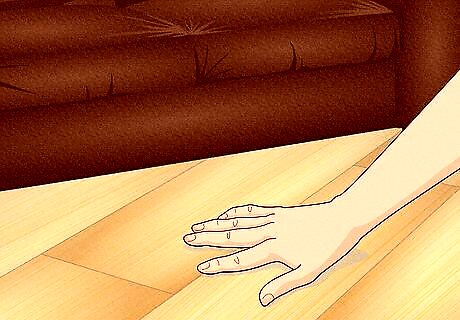
Determine whether the floor has already been treated. You may want to wax a floor that has already been treated, since these surfaces do wear down and get dirty eventually. First, find out which type of product was used: natural ones called wax, or synthetic ones called finish. If the previous owner is unable to tell you, you'll need to examine the floor yourself: If the floor is not shiny or glossy, and you can feel the original material with your finger, it has not been treated. Wipe a small section of the floor with a cloth dipped in mineral spirits or paint thinner. If the cloth turns yellow or brown, your floor has been waxed. If the cloth does not pick up any residue, your floor has been finished.
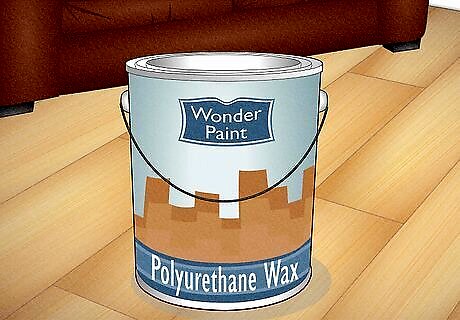
Choose a wax or finish. If your floor has never been treated, you can select any wax or finish product intended for the material your floor is made from. Polyurethane is a popular, glossy option, but each product will appear slightly different, so do your research and determine which look you want. If your floor has already been treated, you'll need to choose the correct option: Wax is difficult to fully remove, since it soaks into the wood. This makes the floor unsuitable for a synthetic finish unless you hire a professional to strip the wax fully, but new wax can be applied without difficulty after stripping, or even simply applied on top if the old layer is only scratched, not dirty. If the floor has been finished, you can go over it with a floor machine with scrubbing pad attachment to remove part of the finish, then apply that same type of finish to improve the appearance. If you can't figure out what type it is, or if you want to use a different type, you'll need to strip the old finish off entirely first. If you don't want to strip a previous finish, you can use a water-based silicone polish instead of waxing. Simply sweep the floor, then apply several even layers of the polish with a mop.
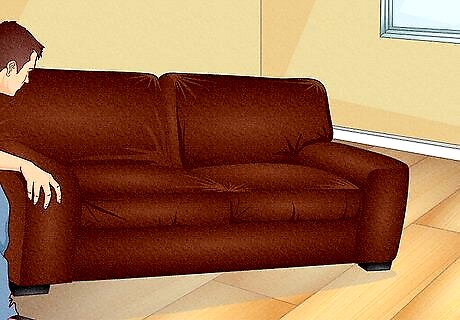
Remove all furniture and objects from the floor. Determine where you plan to wax and remove everything from that area. Put up signs in public areas to let people know the area will be off limits for at least 8 hours. To be extra safe, tape down the edge of any adjacent area to protect it from the wax, especially carpet areas.

Determine whether you need to strip your floor. If your floor has not previously been treated with wax or finish, you can skip straight to Waxing the Floor. If it was treated with wax but the old layer only suffers from scratches, not discoloration, you can also skip straight to waxing. Otherwise, you should continue on to Stripping the Old Finish section to learn how to strip the previous treatment away.
Stripping the Old Finish
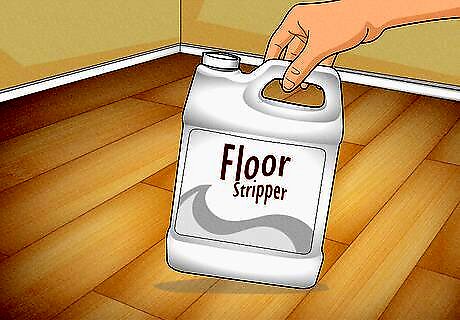
Buy a floor stripping solution suitable for your floor. Having determined what type of finish is on your floor by following the instructions for Preparing the Floor, buy a stripping solution that will remove that type. Also make sure the stripping solution is safe to use on hardwood, or whichever material your floor is made from. If you can't find a product that specifically matches the type of finish previously used on your floor, try out a "universal" floor stripping solution on a small corner of your floor to test it.
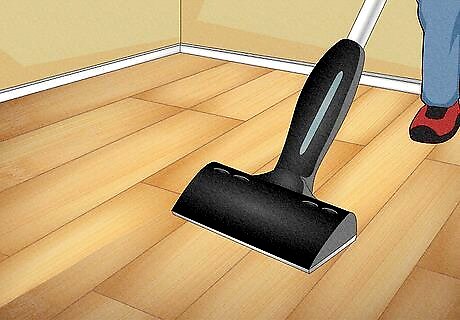
Either vacuum or sweep your floor with a dust mop or broom. Remove all dust and debris from the area using a dust mop if you have one, or a broom if not. Put on clean footwear afterward to prevent further dust from getting on the floor.
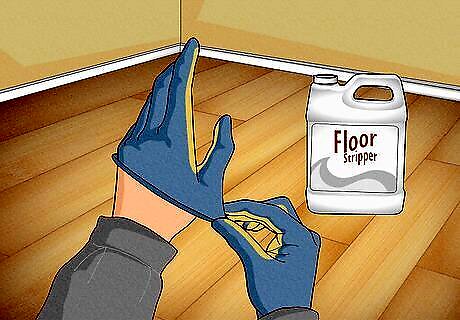
Use safety gear. Chemicals in the solution can be dangerous to the skin or create toxic fumes. Work in a well ventilated area and protect yourself with gloves, long sleeves and pants. Use goggles and a respirator mask for large stripping jobs or poorly ventilated areas. The respirator mask should be labeled as an organic vapor blocker.
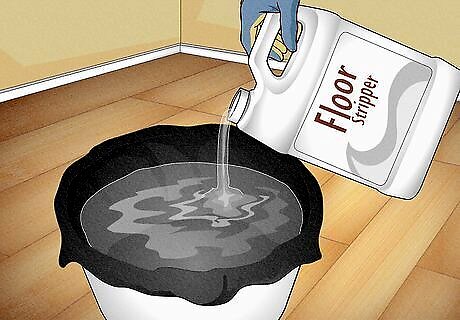
Line a bucket with a trash bag and fill with stripping solution. A heavy duty trash bag allows for easy cleanup and lets you use the bucket for other purposes later. Follow the instructions on the floor stripping solution to determine how much you need, and whether to dilute the solution with water. Have a mop ready. The trash bag is especially essential for mop buckets, since you don't want to later clean your floor with residual floor stripping solution. A "strip mop" is a specialized mop that will do a more effective job, but any mop will do.
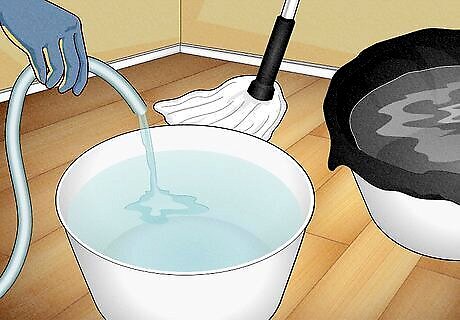
Fill a second bucket with clean water and a second mop. You don't have much time to apply and remove the stripping solution, so it's important to have a second mop handy for cleaning up. The first mop will be too saturated with stripping solution to use for cleaning purposes.
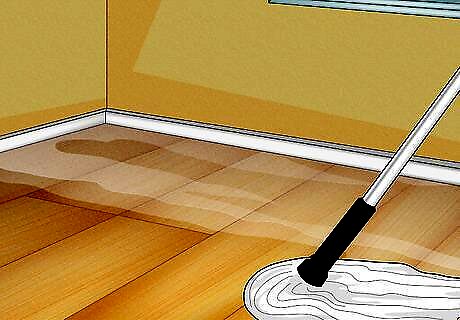
Use a mop to apply floor stripping solution from the far end of the floor to the exit. Stripping solution makes the floor slippery, so plan your route in advance to avoid having to walk over it. Scrub the floor evenly and allow to sit for 5 to 10 minutes, but do not allow it to dry. Try to agitate the finish with your mop as you apply the stripping solution. The stripping solution should change color as it removes and mingles with the finish over the next few minutes. If you are stripping a large floor, do so in small sections so the stripping solution doesn't dry.
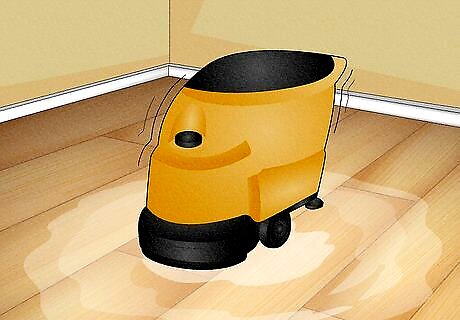
Use an auto scrubber or floor machine to work in the stripping solution (optional). For large jobs, an auto scrubber or rotary machine is recommended, as it will do a thorough job pulling up all the finish. If using an auto scrubber, scrub the area leaving the squeegee tool up (not in use). If using a floor machine or burnishing machine, use the stripping pad attachment. Large jobs may require multiple stripping pads.

Scrape wax from the edges and corners of the floor. You can use a doodle pad for this or a long handled razor blade tool such as a poll scraper. If you don't want to buy a specialized tool, any sharp flat blade such as a putty knife will do the job. Without stepping on the slippery floor stripping solution, use the blade to work the wax away from edges, where the stripping solution and mop have difficulty pulling off the finish. You may need to scrub the baseboard as well, if it has picked up wax residue. You can purchase a special baseboard stripping pad if you are using a floor machine.
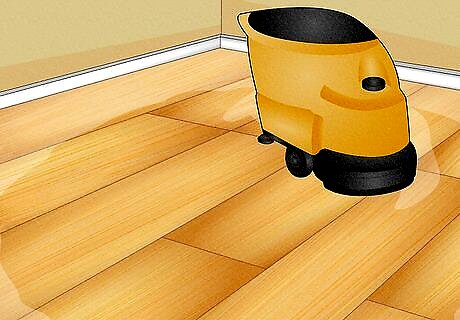
Remove the stripping solution and finish with a wet vacuum or auto scrubber. Do this after the finish has been worked off but before the solution has dried. If you worked in the stripping solution with an auto scrubber, simply lower the squeegee attachment and pick it up again. Otherwise, you'll need a wet vacuum to remove the solution. If a section begins to dry out, pour a little water from your clean water bucket to keep it wet.
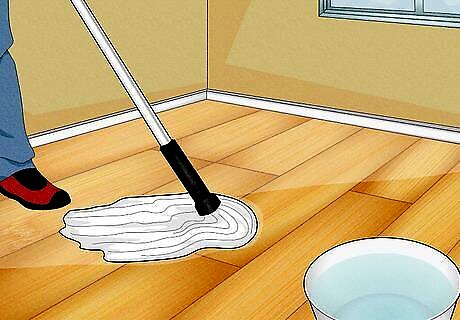
Wash your floor using the clean mop and water bucket. Rinse several times to ensure all stripping solution is removed. You can add a stripping neutralizer to your water to ensure the next wax will adhere properly. If you don't want to buy one, simply wash it thoroughly several times. You can use an auto scrubber or floor machine for this step as well, as long as you change the pad beforehand. Don't use the same pad you used to apply or wipe up the stripping solution.
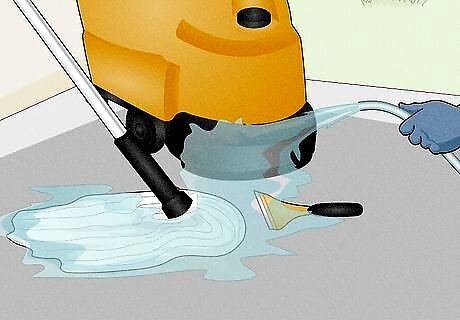
Wash all tools used. Thoroughly clean any tools used, including the interior of machinery hoses and tanks. If left uncleaned, the stripping solution will dry into a hardened mess and ruin your tools.
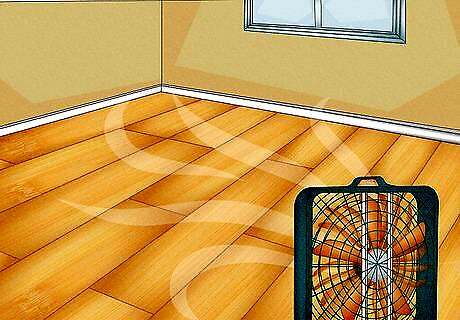
Let your floor dry completely. Don't move on to waxing your floor until it is completely dry, or the wax may not attach properly. You can put a fan in the room to hasten the drying process.
Waxing the Floor

Follow manufacturer's instructions if you are using a finish instead of a wax. Floor wax is a natural product that works into the pores of the wood. If you are trying to create a similar result using a synthetic finish, which bonds over the wood, you will need to follow the specific instructions that came with your product. Polyurethane, the most common modern finish, should be stirred, then applied as quickly as possible and in one back and forth layer across the room, overlapping the previous stroke so you keep a wet edge. You should wear an organic vapor respirator mask and keep a fan blowing out a window while you work.
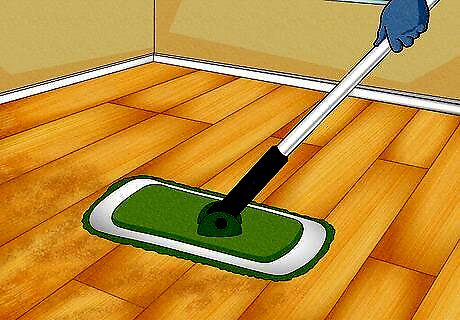
Sweep and mop your floor until it's as clean as you can make it. Use a dust mop to pick up as much dust and as many small particles as possible. Anything you don't get off the floor is likely to get caught in the wax, where it will stay until someone strips off the wax.
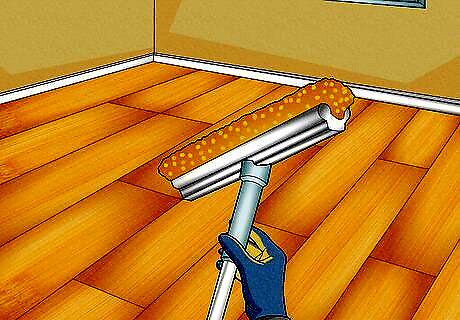
Use a new sponge mop or flat wax applier mop. Never use a used mop, even if it doesn't look dirty. Sponge mops that have also been used for cleaning the floor are likely to introduce dirt into the wax, ruining the look.
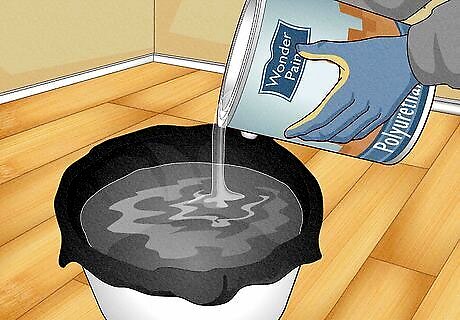
Line the mop bucket with a garbage bag and fill with floor wax. The trash bag prevents the wax from caking onto the mop bucket and ruining it for future uses. If you are using a flat wax applicator mop, you can skip this step. Those mops are designed to have the wax poured directly onto the mesh backing on the upper side.

Apply wax to your mop. Immerse a sponge mop into the wax, or pour some wax onto the upper side of a flat wax applicator mop. If your mop is dripping, you should press it into the wringer portion of the mop bucket or press it against the sides of the bucket. Don't actually wring your mop; the goal is to make it damp with wax, not dry or dripping.

Apply the wax to one small section of floor at a time. Start at the opposite end of the room from the door so you don't have to cross the waxed portion to leave the room. If you try to wax too large an area at once, you are more likely to miss spots or apply the wax unevenly. If your first layer is too thick, the whole process could fail to set properly. Be careful not to drip excess wax onto the floor, and only use a damp,not soaked mop. Once the floor in one section is evenly covered, mop over it with broad strokes in the same direction to create an even appearance. Now you can move on to the next section.
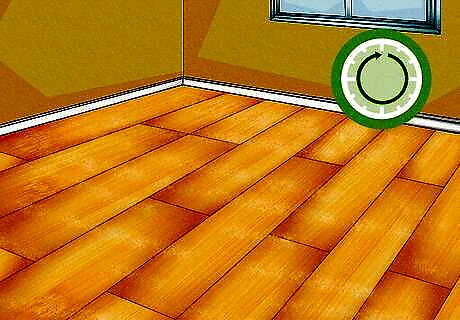
Wait for it to dry completely. This should take about half an hour, but could be longer in areas with high humidity. After ten minutes of natural drying, you can point a fan into the room to make it dry faster, but do not point it directly at the waxed floor. This could interfere with the adhesive. Read the label of your floor wax for more accurate estimate of drying time.
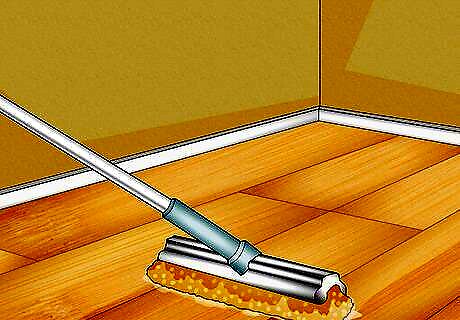
Apply additional layers the same way. After the previous layer is completely dry, wax the floor again. Remember to do it in sections and plan your route to the door. Your specific floor wax product should include a recommended number of coats. If it doesn't, apply three or four thin coats. Stop if the wax starts turning yellow. Avoid stepping on or placing anything onto the final coat for 8 full hours to ensure a perfect finish.
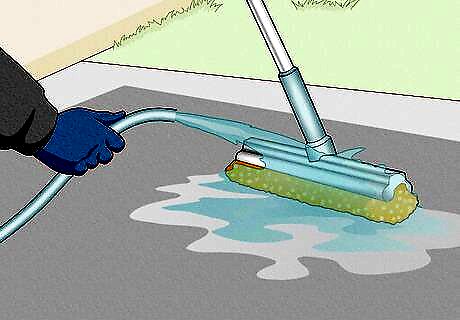
Wash all tools immediately. If you allow the wax to dry it will be extremely difficult to remove. Scrub it off of any tools you plan on using again using soap and hot water.
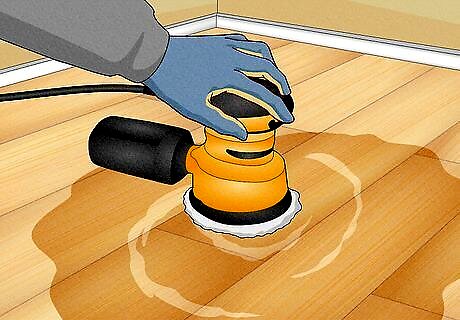
Buff the floor if it the wax requires it. Many waxes are no-buff and will remain glossy with no further effort. Others require polishing with a buffing pad or burnishing machine. If you don't want to track down specialized equipment, simply use a clean, dry terry cloth towel to polish your floor with a circular motion. Tie the towel around a dry mop head and you don't have to be on your hands and knees. A buffing pad can be attached under the brush of the floor machine and used to buff the floor.
Caring for a Waxed Floor

Reapply wax to the floors regularly. Wooden floors should have an additional layer of wax added once every six to twelve months. Vinyl floors should be waxed every six months, as should sealed ceramic or stone floors.
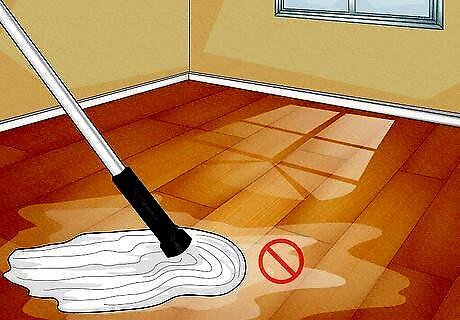
Don't use a soaking mop, and never mop waxed hardwood. The wax seal is not watertight, so the water could damage the wood. Wipe up spills with a damp paper towel instead. Vinyl and other non-wood surfaces can be cleaned with a damp mop, not a soaking one. This does not apply to wood treated with polyurethane, which can be mopped with a mop dampened by a mixture of one quart (1 liter) water and 1/4 cup (60 mL) vinegar.
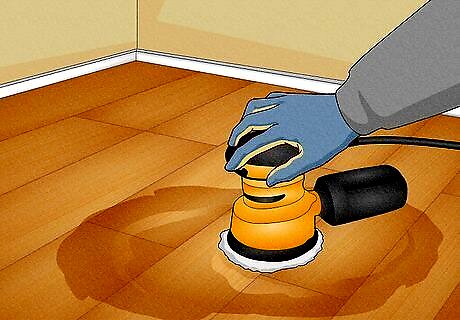
Buff or polish the floor if the shine fades. Use a terry cloth or buffing pad to polish the floor if it begins to get dull. This shouldn't be necessary for no-buff wax.

Sand or scrub off part of the wax if it becomes yellowed or discolored. If you don't want to do this manually, use a floor machine with a light scrubbing pad just strong enough to remove a small portion of the wax. You should apply a new layer or two of wax after removing some to create a strong protective layer again. This should not be required for several years at least if your floor was waxed properly.












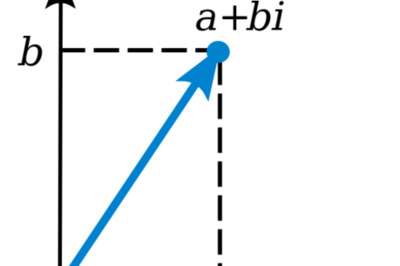
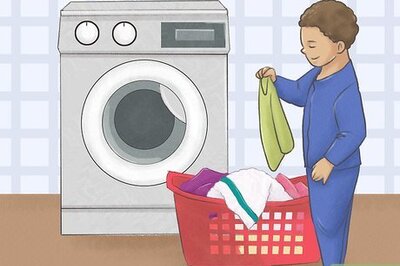

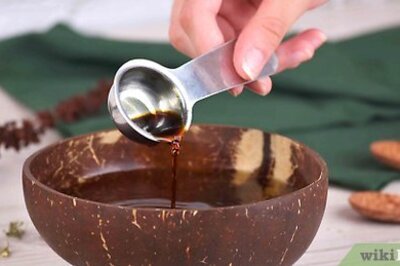


Comments
0 comment